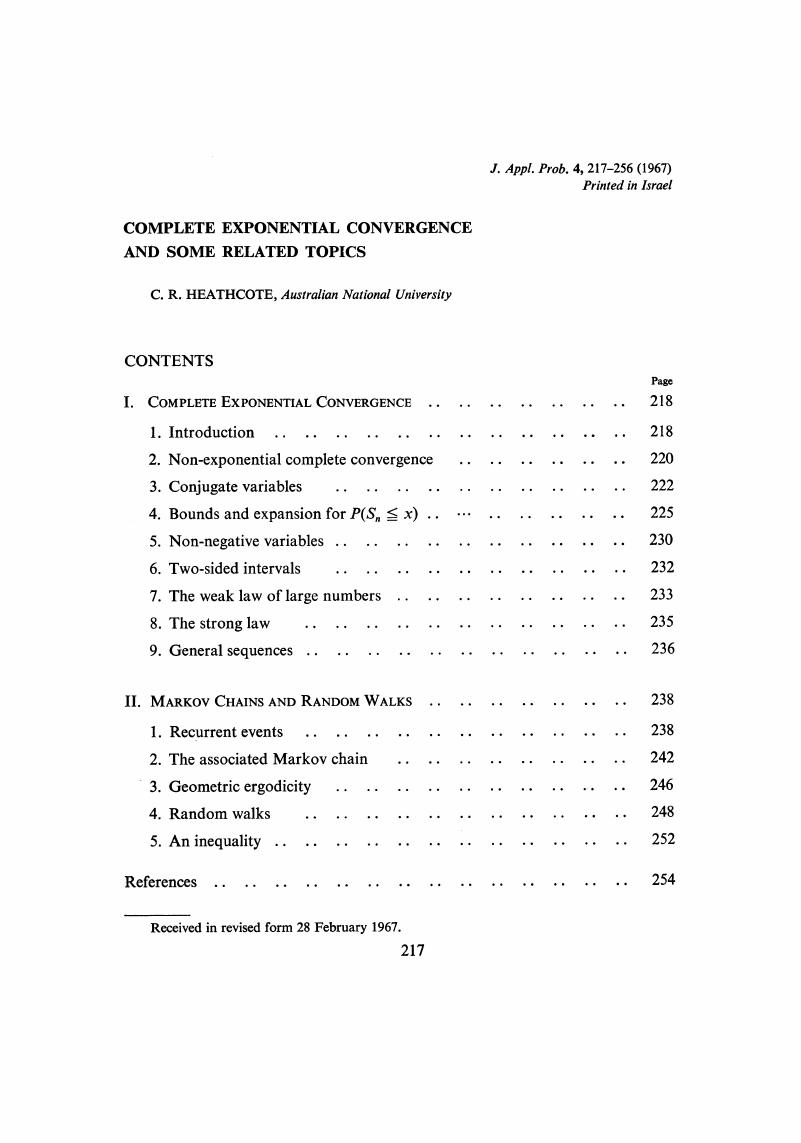Crossref Citations
This article has been cited by the following publications. This list is generated based on data provided by Crossref.
Blomqvist, Nils
1968.
Estimation of waiting-time parameters in the GI/G/1 queuing system.
Scandinavian Actuarial Journal,
Vol. 1968,
Issue. 3-4,
p.
178.
Heathcote, C. R.
1969.
An expansion related to the central limit theorem.
Journal of the Australian Mathematical Society,
Vol. 10,
Issue. 1-2,
p.
219.
Mamatov, M.
and
Formanov, Sh. K.
1970.
Estimating probabilities for sums of independent random vectors.
Mathematical Notes of the Academy of Sciences of the USSR,
Vol. 7,
Issue. 2,
p.
130.
Tweedie, Richard L.
1971.
Stationary measures for random walk on a half line.
Zeitschrift f�r Wahrscheinlichkeitstheorie und Verwandte Gebiete,
Vol. 20,
Issue. 1,
p.
28.
Cheong, Choong K.
and
Teugels, Jozef L.
1973.
On a semi-Markov generalization of the random walk.
Stochastic Processes and their Applications,
Vol. 1,
Issue. 1,
p.
53.
Callaert, Herman
and
Keilson, Julian
1973.
On exponential ergodicity and spectral structure for birth-death processes, II.
Stochastic Processes and their Applications,
Vol. 1,
Issue. 3,
p.
217.
Callaert, Herman
and
Keilson, Julian
1973.
On exponential ergodicity and spectral structure for birth-death processes I.
Stochastic Processes and their Applications,
Vol. 1,
Issue. 2,
p.
187.
Iglehart, Donald L.
and
Lemoine, Austin J.
1974.
Approximations for the repairman problem with two repair facilities, II: Spares.
Advances in Applied Probability,
Vol. 6,
Issue. 1,
p.
147.
Iglehart, Donald L.
1974.
Random walks with negative drift conditioned to stay positive.
Journal of Applied Probability,
Vol. 11,
Issue. 4,
p.
742.
Iglehart, Donald L.
1974.
Random walks with negative drift conditioned to stay positive.
Journal of Applied Probability,
Vol. 11,
Issue. 4,
p.
742.
Veraverbeke, N.
and
Teugels, J. L.
1975.
The exponential rate of convergence of the distribution of the maximum of a random walk.
Journal of Applied Probability,
Vol. 12,
Issue. 2,
p.
279.
Veraverbeke, N.
and
Teugels, J. L.
1975.
The exponential rate of convergence of the distribution of the maximum of a random walk.
Journal of Applied Probability,
Vol. 12,
Issue. 2,
p.
279.
Teugels, J. L.
and
Veraverbeke, N.
1975.
On the approach to the limit of successive maxima of partial sums.
Advances in Applied Probability,
Vol. 7,
Issue. 2,
p.
249.
Kotzturek, M.
and
Stoyan, D.
1976.
A quantitative continuity theorem for the mean stationary waiting time in GI/GI/1.
Mathematische Operationsforschung Statistik,
Vol. 7,
Issue. 4,
p.
595.
Veraverbeke, N.
and
Teugels, J. L.
1976.
The exponential rate of convergence of the distribution of the maximum of a random walk. Part II.
Journal of Applied Probability,
Vol. 13,
Issue. 4,
p.
733.
Schramm, K.
1980.
Konvergenzvergleiche bei Lösungen linearer Differenzengleichungen mit konstanten Koeffizienten.
Zeitschrift für Operations Research,
Vol. 24,
Issue. 3,
p.
125.
Gani, J.
1982.
An Adventure in Publishing: Eighteen Years of the Applied Probability Trust1.
Australian Journal of Statistics,
Vol. 24,
Issue. 1,
p.
1.
K�nig, D.
Rykov, V. V.
and
Schmidt, V.
1983.
Stationary queuing systems with dependencies.
Journal of Soviet Mathematics,
Vol. 21,
Issue. 6,
p.
938.
Bingham, Nicholas H.
and
Goldie, Charles M.
1988.
Riesz means and self-neglecting functions.
Mathematische Zeitschrift,
Vol. 199,
Issue. 3,
p.
443.
Sharma, Vinod
1995.
Reliable estimation via simulation.
Queueing Systems,
Vol. 19,
Issue. 1-2,
p.
169.



